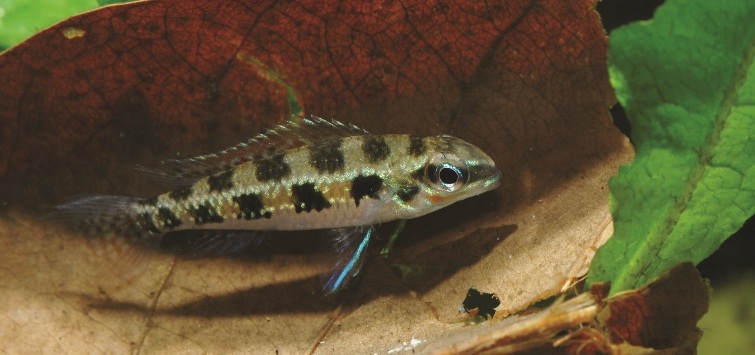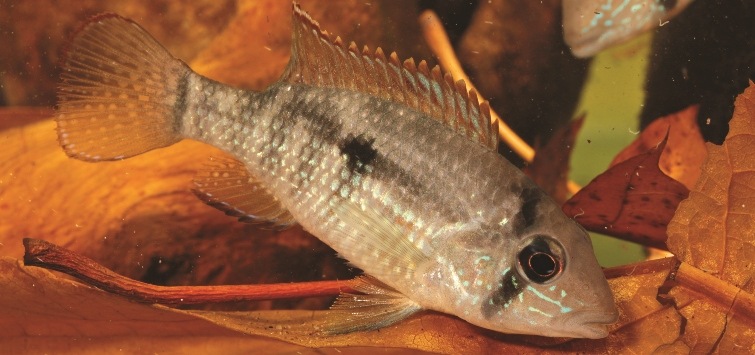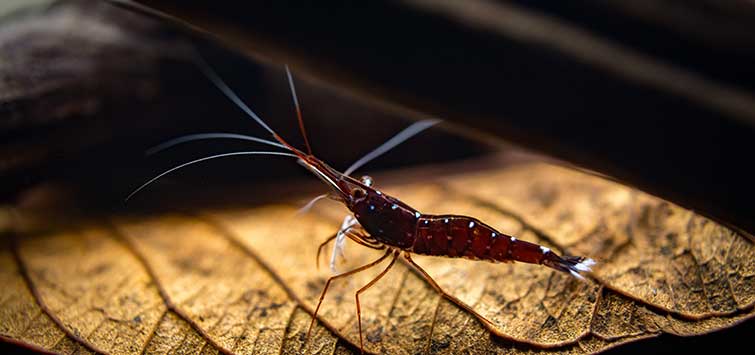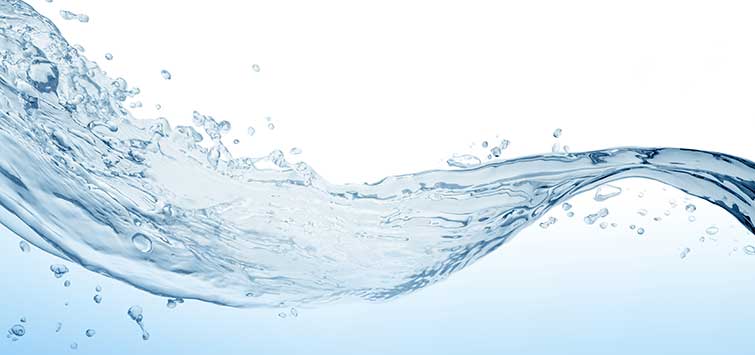Leaf Litter & More: How to Naturally Lower Aquarium pH
Naturally acidifying aquarium water with dried leaf litter is useful for the proper keeping of fish that inhabit the blackwater habitats of the Amazon, and it also comes in handy for the keepers of shrimp, catfish, and snails, for whom these materials are also a natural food. There are a few simple tricks and methods for using leaf litter and other organic materials to acidify your aquarium water naturally.
To begin with, I’d like to caution you not to overestimate the capabilities of these natural methods for lowering aquarium pH. Tree leaves or peat will bring your pH down slightly and gradually, not drastically and quickly. The difference between mineral acids and natural humic substances is that the former are much stronger, making it possible to acidify even hard tap water, which cannot be done using dry leaves or peat.
Also remember that these natural acidification methods are the most effective when we are dealing with soft water, either naturally from the tap or through reverse osmosis (RO) filtration, because the buffering capacity of hard water efficiently neutralizes any acids added to the water. Natural methods of pH lowering are sure to come in handy when keeping demanding fish or ensuring the health of rare and valuable specimens, such as wild-caught fish, for which the use of harsher chemicals may be too risky. These methods can also be useful in the preparation of water for difficult-to-breed species hailing from blackwater habitats—after their addition to the tank, such fish have been observed to lay eggs almost spontaneously.
Using peat, leaves, or other natural methods, we bring the pH down gradually, at the same time staining the water the color of cola and introducing valuable organic compounds (tannins), which, among other things, disinfect the water. Dried tree leaves also make interesting natural decorations and provide a refuge for smaller fish. Some species lay their eggs among them, and their newly hatched fry will find copious microorganisms on their surfaces to feed upon in their first days of foraging.
Ornamental freshwater shrimp can also be observed grazing on dried leaves, such as those of the ketapang tree. The decaying process of the leaves helps to bring the aquarium water closer to the natural conditions that are found in a stream or a river flowing through a forested area.
As for the question of how many leaves to put in the aquarium to obtain the desired effect, there is no hard-and-fast answer. It depends on many factors, including what tree the leaves came from, their size, and the existing parameters of your water. Each of us must experiment by trial and error to find the “sweet spot” for our individual setups.
Dry Tree Leaves

It is best to take leaves that have fallen from the tree or to take them after the first frost. The point is for the leaves to be free of sap. Furthermore, they should be gathered in the autumn (not in the spring), ideally when the weather is dry and they have not yet been rained on, as rain can leach valuable compounds from them. They should also be healthy and undamaged, without spots or discolorations.
Once you have them in hand, you can either put them into the tank directly—it is best to weigh them down with a heavy object, however, or they will float—or take a few liters of RO water, place a handful of leaves in it for a few days, and then measure the pH. Then the water together with the leaves (which, having been soaked, should sink on their own) can be gradually poured into the aquarium. The pH should then be monitored until it stabilizes and the desired effect is achieved.
Other leaves that are useful, and as effective as oak for the purposes of acidifying water, are those of the beech tree, which lower aquarium pH slightly, and hornbeam, which lower the pH rapidly and considerably.
In the aquarium hobby, we also use the leaves of such trees as Norway maple, poplar, birch, hazel, sycamore maple, and plane.
Leaves of the walnut tree are another option. Apart from acidifying the water, they have anti-inflammatory, bactericidal, and fungicidal properties. These leaves should be collected when green and then dried. They are a valuable addition to the diet of dwarf shrimps, among other creatures. If first parboiled, they will release tannins faster, and your shrimp can start feeding on them sooner.
Yet another type of aquarium leaves used by shrimp-keepers are those of the white mulberry. These provide tannins and organic acids, are a source of protein and amino acids, and contain B vitamins and minerals. As with beech leaves, they should be gathered while still green and then dried.
As for leaves that can be purchased in aquarium shops, look for Terminalia catappa, also known as Indian almond or ketapang. Liquid extracts and bark from this tree are also available. This tree grows primarily in the tropical regions of Asia, Africa, and Australia. Dried leaves of Indian almond are used in shrimp-keeping because they naturally improve the quality of the water in the tank. Ketapang releases natural tannins into the water and lowers the pH, creating an environment similar to a blackwater biotope.
Indian almond leaves also ameliorate the harmful effects of heavy metals in the water. Under the influence of water, the leaves release humic acids and tannins. Ketapang leaves have been known and used for a long time in Asia by keepers of blackwater fish and shrimp. They are one of the better natural means of improving the conditions in aquaria, whether ornamental or intended for breeding. Known for their antibacterial and antifungal properties, they improve the condition of fish suffering from fin rot, wounds, and abrasions.
Leaves of the Indian almond tree are also useful in daily disease prevention for fish and shrimp, improving fertility and intensifying coloration. In Asia, betta breeders use the dried leaves as surfaces for bubblenest building and to introduce substances that protect the fry from disease. As a bonus, the decaying aquarium leaves turn into detritus on which microorganisms grow that the fry can feed on.
In addition to acidifying the water, ketapang leaves hasten the regeneration of mucous membranes, the epidermis, and fin tissue; reduce the risk of fungal diseases in adult fish; protect eggs from fungus; and increase the survival rate of fry. They are also a source of food for shrimp and catfish—after a few days, when the leaf has been well soaked, the shrimp begin to eat it and keep at it until only a few veins are left.
Alder Cones
For the record, and as an interesting tidbit, I have observed that the cones of the black alder (Alnus glutinosa), a tree from Europe that grows in the vicinity of swamps and water bodies, are used in the aquarium hobby to lower pH. These cones are also used in spawning tanks, where they stimulate some species to spawn and prevent the eggs from growing fungus.Peat
Peat can usually be purchased in aquarium shops in a number of forms: liquid (peat extract), fibrous (its natural state), and granulated pellets (processed or compressed, which makes it stronger and longer-lasting than the fibrous variety). The latter two are used as filtration media as well, often in canister filters, but it is also possible to hang a bag with peat in the area of water current where the water exits from a powerhead or filter return—which may not look attractive, but it is easier to change out the peat from a bag in front of a filter return than it would be in a canister filter.As in the case of leaves, the peat method relies heavily on trial and error; you have to establish for yourself how much peat you need in your own tank to lower aquarium pH to a desired value, because not all peat is created equal, and its humic acid content can vary widely. Dosing should be as per the manufacturer’s instructions.
Humic substances contained in peat are at their most effective in soft water. It is advisable to check the alkalinity—or carbonate hardness—of your water in advance, because in the presence of high alkalinity, the effect of any pH-lowering material will be quite fleeting. This is why it is advisable to soften harder water beforehand, by adding RO water for example.
While we are on the subject of peat, I might also mention lignite, which is a transitional phase between peat and brown coal (a stage in the development of brown coal). It is used for aquarium decoration, often as a background, or for hiding places, often with mosses or Anubias planted on it.
Depending on the amount, quality, and place of origin, lignite may acidify the water slightly due to its humic compounds. It also enriches the water with minerals and can serve as an egg-laying substrate for fish such as Uaru, discus, angelfish, or catfish. The latter also consume it to obtain ballast substances that their bodies need. As with peat, you have to experiment to establish how much lignite to add to lower the pH.
Beware of Tannin Overdose

Tannins dissolve in water, and they are used in the aquarium hobby to limit the growth of bacteria. Employed in moderation, they can also play a part in other processes, such as protecting eggs from fungus attacks that cause them to die off.
Unfortunately, it is possible to overdose tannins unintentionally in the aquarium by using too many leaves or too much peat. Too high a concentration of tannins in the water causes the fish’s mucus to coagulate, which, among other things, can result in the gill filaments sticking together, thus disrupting gas exchange and potentially causing suffocation. A fish suffering from this may be observed gasping at the surface of the water.
There could also be some skin irritation caused by excess tannins. When something like this happens, the only remedy is an immediate, large water change, and if there are any loose aquarium leaves or peat fibers, they should be taken out. Do keep in mind that leaves, peat, and their extracts should be dosed in moderation and with care.
Natural Additives
Adding materials like dried tree leaves and peat is an increasingly popular way to lower aquarium pH. The leaves can also be used in various other ways—for decoration, as food, to achieve the right ambience in the tank, and to make the bottom look naturalistic, similar to the leaf litter substrates typical of rivers and streams in the Amazon and Southeast Asia.They will give the water a slightly brownish tinge, which is useful for keeping fish that hail from dark-colored, soft waters, such as cardinal tetras, discus, altum angels, Satanoperca eartheaters, and other fish from the Amazon. These fish were gifted by Mother Nature with intense coloration that reflects the weak light diffused in those dark waters. This makes their bodies seem to shine, which allows them to orient themselves within a group in those dark, tea-colored waters, facilitating the schooling behavior that fish such as cardinal tetras are known and kept for.
Furthermore, decay of the leaves will bring the chemistry of the aquarium water closer to the natural conditions found in forest streams and rivers. Another advantage of aquarium leaves is that they can be collected for free—just go for a walk on a sunny, dry autumn day and collect them in unindustrialized areas. This way, you get two good things at once: some exercise in the fresh air for yourself, and leaves for your blackwater charges.
And on autumn and winter evenings, your reward will be the opportunity to enjoy the sight of the leaves scattered along your tank’s substrate and the happy, healthy, beautifully colored fish swimming among them.
See the full article on TFH Digital
https://www.tfhdigital.com/tfh/sep_oct_2018/MobilePagedReplica.action?pm=2&folio=54#pg57a

.png?h=595&iar=0&w=2781&hash=5FD5E69473BCC22199FBFA2FB71B6033)



